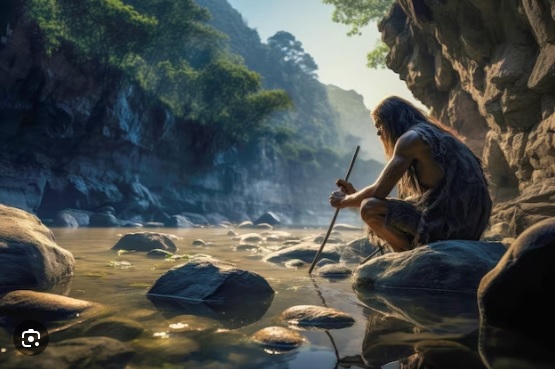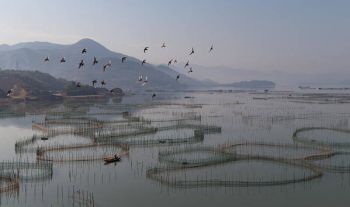Difference between revisions of "Fishing (technology)"
Tao alexis (talk | contribs) |
Tao alexis (talk | contribs) |
||
| (16 intermediate revisions by 2 users not shown) | |||
| Line 1: | Line 1: | ||
| − | ''Give a man a fish and you feed him for a day. Teach a man to fish and you feed him for a lifetime. | + | [[File:Fishing (technology).jpg|right|560px|thumb]] |
| − | + | ''Give a man a fish and you feed him for a day. Teach a man to fish and you feed him for a lifetime.'' — Lao Tzu | |
| − | |||
| + | '''Fishing''' emerged within the context of the broader human strategy of [[Hunting (technology)|hunting]] and gathering of food. The advancement, occurring in the [[Palaeolithic Period|Palaeolithic]], represented a significant development in how early humans exploited aquatic resources to supplant their diet and sustain gathering sites along the sea shore and water routes. Fish were a source rich in protein, supporting population growth and eventually small [[Settlements|settlements]] in the [[Mesolithic Period]]. | ||
__TOC__ | __TOC__ | ||
| − | + | The most primitive parts of the world, where possible, include coastal communities focused on fish and marine life, using techniques like netting, spearing and beach-seining to [[Catch Fishing (sage ability)|catch fish]] and other water-based creatures, or trapping that enabled hand-gathering of freshwater fish in rivers. | |
| − | |||
| − | |||
| − | |||
| − | |||
| − | |||
| + | == Applications == | ||
| + | Listed in order of advancement. Additions are changes to the production of [[6-mile Hex Map|6-mile hexes]]. | ||
{| class="wikitable" style="float:right; margin-left: 15px; text-align: center; background-color:#d4f2f2;" | {| class="wikitable" style="float:right; margin-left: 15px; text-align: center; background-color:#d4f2f2;" | ||
|- | |- | ||
| − | + | ||
|- | |- | ||
| − | | | + | | weir construction || 5 |
| − | |||
| − | |||
| − | |||
| − | |||
|- | |- | ||
| aquaculture || 6 | | aquaculture || 6 | ||
|- | |- | ||
| − | | bow fishing || 6 | + | | [[Bow Fishing (sage ability)|bow fishing]] || 6 |
|- | |- | ||
| outward fishing || 6 | | outward fishing || 6 | ||
| Line 32: | Line 25: | ||
| salted fish || 6 | | salted fish || 6 | ||
|- | |- | ||
| − | | | + | | [[Catch Fishing (sage ability)|catch fishing]] || 7 |
|- | |- | ||
| trap fishing || 7 | | trap fishing || 7 | ||
| Line 40: | Line 33: | ||
| deep sea fishing || 8 | | deep sea fishing || 8 | ||
|} | |} | ||
| + | |||
| + | '''Hand gathering''', the harvesting of sea foods and products without the use of tools, including picking up shellfish or kelp, digging for clams or crabs, diving underwater to catch abalone or lobsters, [[Flounder Tramping (sage ability)|flounder tramping]], [[Noodling (sage ability)|noodling]] for catfish with bare hands, [[Trout Binning (sage ability)|trout binning & tickling]], and [[Pearl Diving (sage ability)|pearl diving]]. | ||
| + | :: Adds +1 food to type-7 hexes that are water-adjacent. Replaced by angling (tech-7). | ||
'''Catch fishing''', also called artisanal fishing, is primitive fishing method employing boats for making short (rarely overnight) fishing trips along [[Intertidal (range)|intertidal]] and [[Wetland (range)|wetland]] ranges. The catch sets out to obtain food that is rarely marketed, with sufficient amounts to meet the community's subsistence needs. | '''Catch fishing''', also called artisanal fishing, is primitive fishing method employing boats for making short (rarely overnight) fishing trips along [[Intertidal (range)|intertidal]] and [[Wetland (range)|wetland]] ranges. The catch sets out to obtain food that is rarely marketed, with sufficient amounts to meet the community's subsistence needs. | ||
| Line 50: | Line 46: | ||
[[File:Aquaculture.jpg|right|350px]] | [[File:Aquaculture.jpg|right|350px]] | ||
'''Aquaculture''' is the farming of fish, crustaceans, mollusks, aquatic plants, algae and other living things in [[Stock Pond|stock ponds]]. The method involves cultivating freshwater and saltwater stocks whose numbers are maintained, unlike the harvesting of ''wild fish''. When done in intertidal ranges, it is called ''mariculture''. A rearing process is used to create larger and better tasting stocks. Humanoids in subterranean cultures often employ aquaculture. | '''Aquaculture''' is the farming of fish, crustaceans, mollusks, aquatic plants, algae and other living things in [[Stock Pond|stock ponds]]. The method involves cultivating freshwater and saltwater stocks whose numbers are maintained, unlike the harvesting of ''wild fish''. When done in intertidal ranges, it is called ''mariculture''. A rearing process is used to create larger and better tasting stocks. Humanoids in subterranean cultures often employ aquaculture. | ||
| − | : — Tools include the use of shellfish traps and fishing net baskets stabilized by bamboo and wattle fencing. | + | : — Tools include the use of shellfish traps and fishing net baskets stabilized by [[Bamboo Grass |bamboo]] and wattle fencing. |
:: Adds +1 food to type-4 hexes and above that are sea or lake adjacent. | :: Adds +1 food to type-4 hexes and above that are sea or lake adjacent. | ||
| Line 61: | Line 57: | ||
:: Adds +1 food and +1 labour to type-2/3 hexes; +2 food to type 1 hexes, when sea adjacent. | :: Adds +1 food and +1 labour to type-2/3 hexes; +2 food to type 1 hexes, when sea adjacent. | ||
| − | |||
| − | |||
| − | |||
| − | |||
| − | |||
| − | |||
See Discussion for more notes. | See Discussion for more notes. | ||
Latest revision as of 01:51, 1 September 2023
Give a man a fish and you feed him for a day. Teach a man to fish and you feed him for a lifetime. — Lao Tzu
Fishing emerged within the context of the broader human strategy of hunting and gathering of food. The advancement, occurring in the Palaeolithic, represented a significant development in how early humans exploited aquatic resources to supplant their diet and sustain gathering sites along the sea shore and water routes. Fish were a source rich in protein, supporting population growth and eventually small settlements in the Mesolithic Period.
Contents
The most primitive parts of the world, where possible, include coastal communities focused on fish and marine life, using techniques like netting, spearing and beach-seining to catch fish and other water-based creatures, or trapping that enabled hand-gathering of freshwater fish in rivers.
Applications
Listed in order of advancement. Additions are changes to the production of 6-mile hexes.
| weir construction | 5 |
| aquaculture | 6 |
| bow fishing | 6 |
| outward fishing | 6 |
| salted fish | 6 |
| catch fishing | 7 |
| trap fishing | 7 |
| smoked fish | 7 |
| deep sea fishing | 8 |
Hand gathering, the harvesting of sea foods and products without the use of tools, including picking up shellfish or kelp, digging for clams or crabs, diving underwater to catch abalone or lobsters, flounder tramping, noodling for catfish with bare hands, trout binning & tickling, and pearl diving.
- Adds +1 food to type-7 hexes that are water-adjacent. Replaced by angling (tech-7).
Catch fishing, also called artisanal fishing, is primitive fishing method employing boats for making short (rarely overnight) fishing trips along intertidal and wetland ranges. The catch sets out to obtain food that is rarely marketed, with sufficient amounts to meet the community's subsistence needs.
- — Tools include the use of fishing line made of gut or woven fibre, which is woven to make fishing nets or is used with gaffs, bone hooks and barbed spears. Fishing boats consist of lightly-built, narrow craft suitable for 1-3 persons, made of natural materials and lacking the strength to survive a storm in deep water. Caulking is done with natural materials.
- Adds +2 food to type-6 hexes and above that are water-adjacent.
Dried fish, a method of food preservation that uses sun and wind to remove water by evaporation. In northern lands, the food is first frozen and water is removed by sublimation. Drying fish is the world's oldest known preservation method, with dried fish having a storage life of several years. The method is cheap and effective in suitable climates and can be done by the fisherfolk prior to tranferring it to market.
- Adds +1 labour to type-5 hexes and above that are water-adjacent. Advanced by salting (tech-6) and smoking (tech-7).
Aquaculture is the farming of fish, crustaceans, mollusks, aquatic plants, algae and other living things in stock ponds. The method involves cultivating freshwater and saltwater stocks whose numbers are maintained, unlike the harvesting of wild fish. When done in intertidal ranges, it is called mariculture. A rearing process is used to create larger and better tasting stocks. Humanoids in subterranean cultures often employ aquaculture.
- — Tools include the use of shellfish traps and fishing net baskets stabilized by bamboo and wattle fencing.
- Adds +1 food to type-4 hexes and above that are sea or lake adjacent.
Bowfishing, uses barbed arrows with fishing line, enabling the drawing in by hand or using a reel. Commonly hunted species include carp, gar and bowfin in freshwater, rays and shark in saltwater. Bowfishing arrows are considerably heavier and stronger than archery arrows. Bowfishers most often shoot from boats.
- — Tools include the introduction of archery.
- Adds +1 health to type-7 hexes. Fishing clans count 2-5 bow proficiencies among war parties.
Outward fishing, describes the exploitation of fisheries upon ocean bank ranges, demanding journeys of 2-5 days. There, sufficient fish can be caught to enable marketing. The presence of ocean currents and weather demands stronger boats and boatmaking artisans.
- — Boatyards consist of blocks where boats are assembled and repaired, with primitive workshops, channels, piers, embankments and roofed shacks. Usually but not always, boatyards are located upon a natural harbour. Umiaks are open skin boats for 4-10 hunters that are paddle-driven and covered-over to ride in deep seas. Karvi are primitive longboats (less than a catamaran) that will enable 18 rowers and 17 additional passengers, used for fishing, trade and war. Later karvi have sails (tech-8)
- Adds +1 food and +1 labour to type-2/3 hexes; +2 food to type 1 hexes, when sea adjacent.
See Discussion for more notes.

